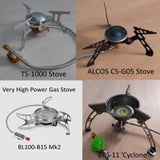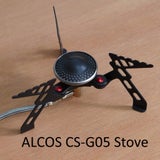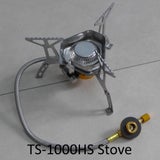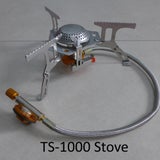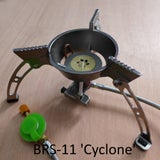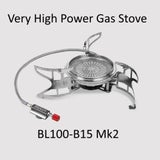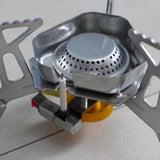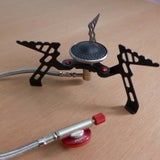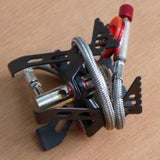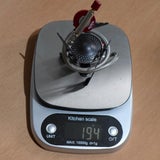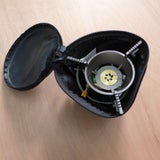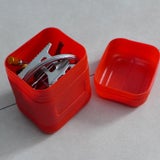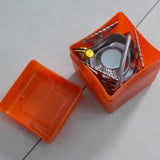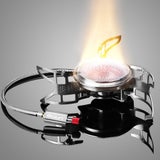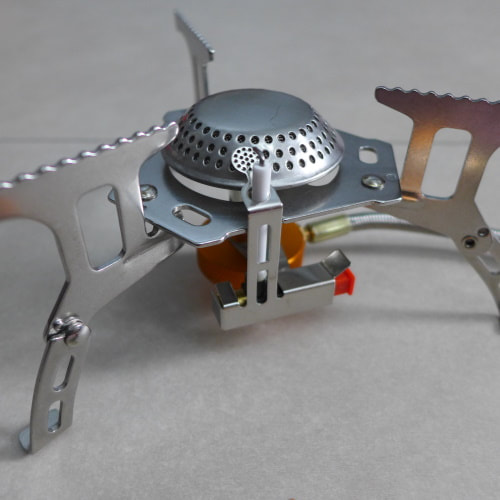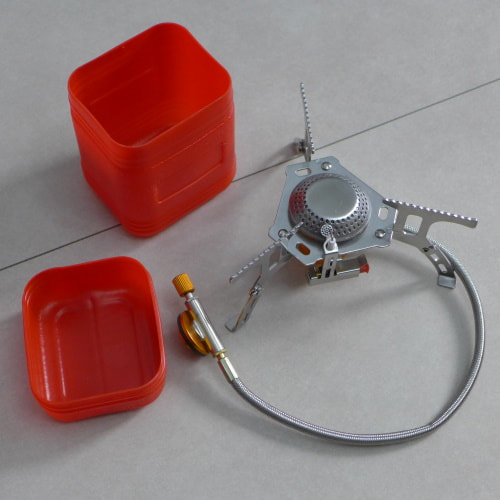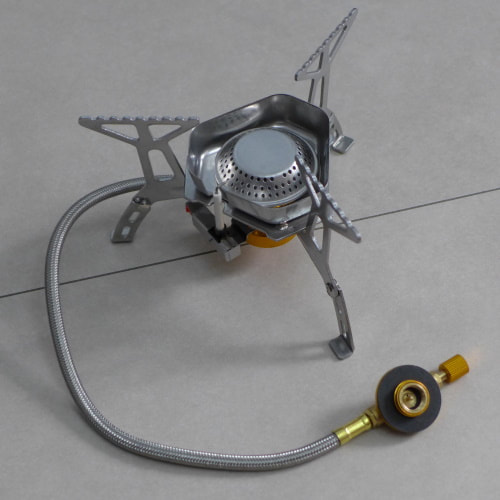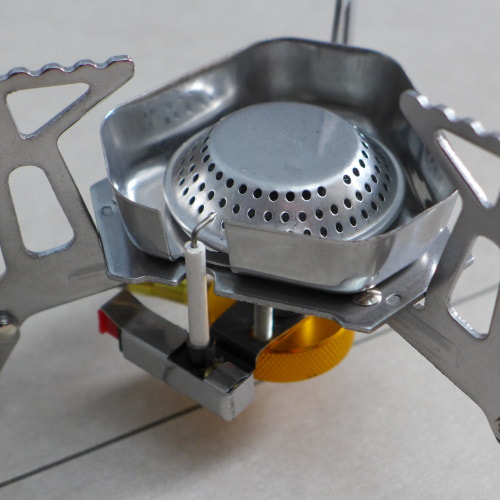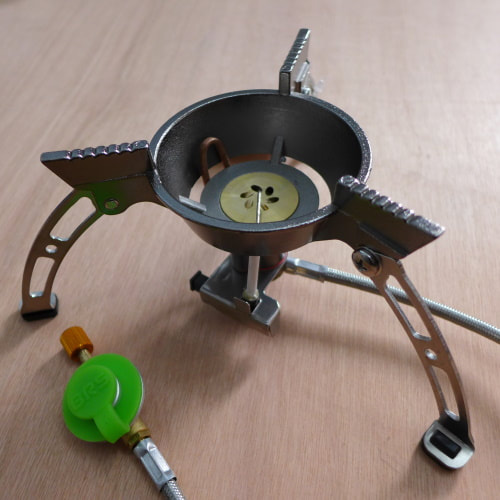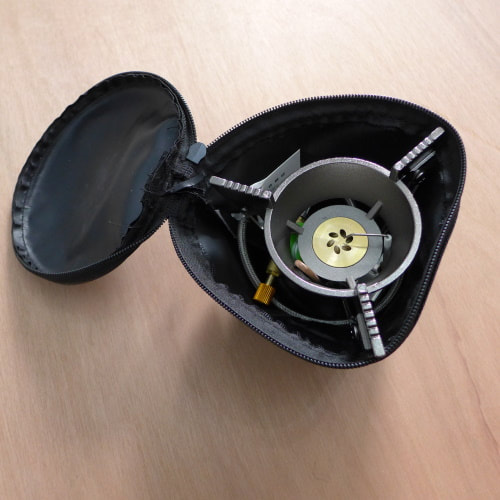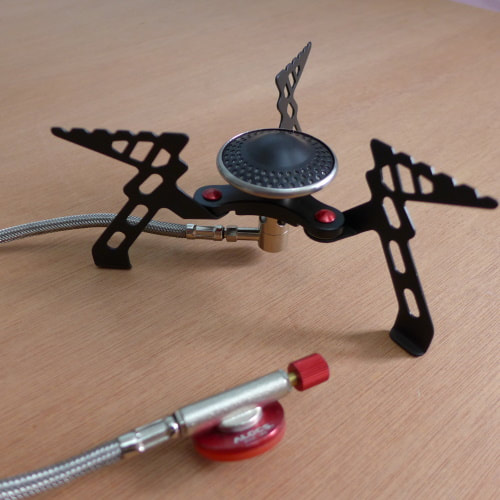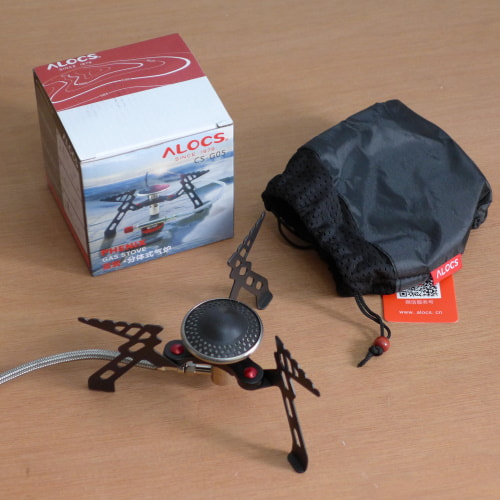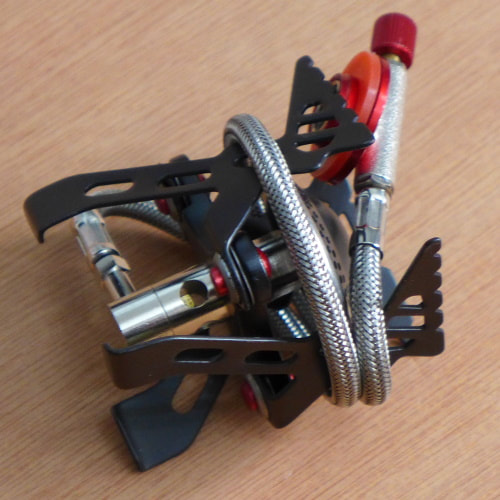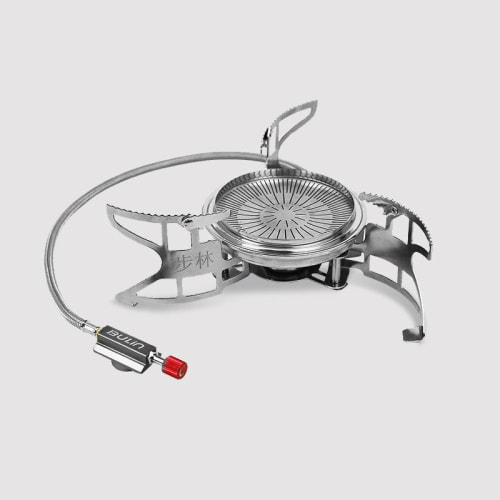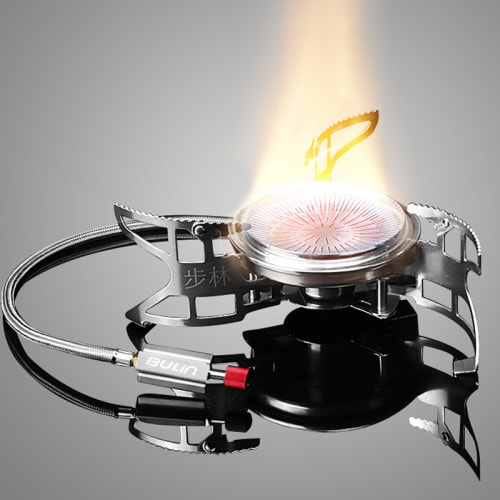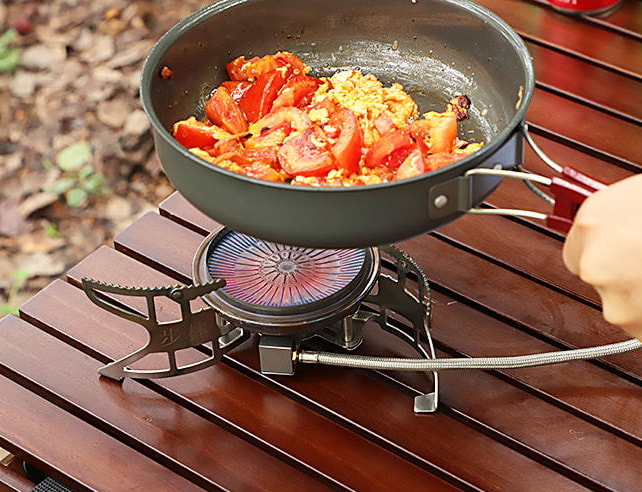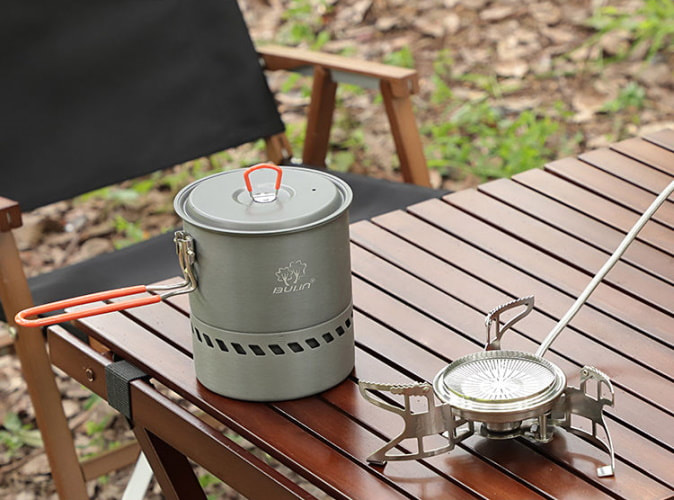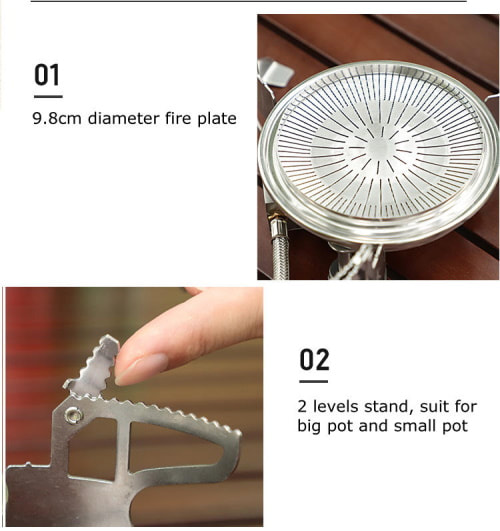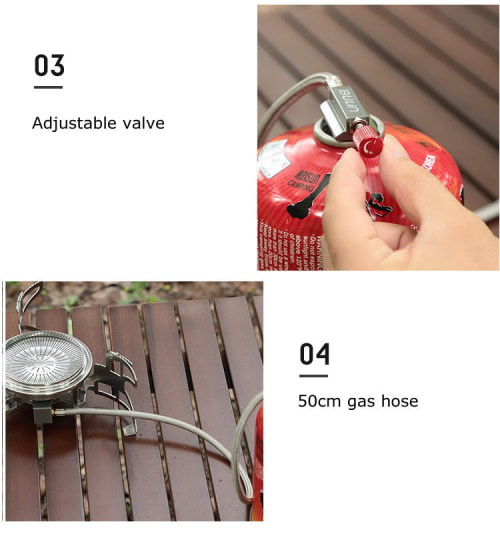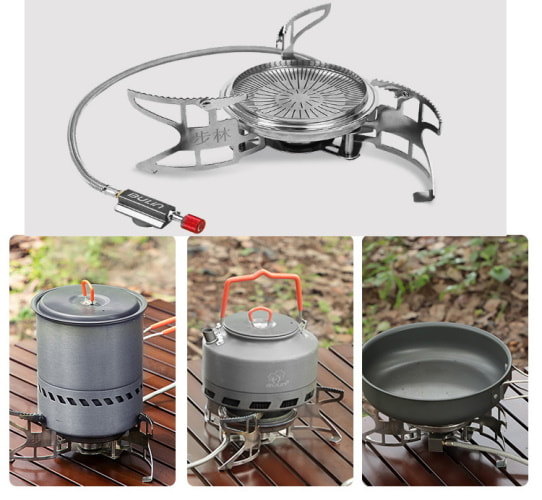- STATION13
- >
- Lightweight Camping Stoves
- >
- Lightweight Backpacking & Camping Gas Stoves
Lightweight Backpacking & Camping Gas Stoves
SKU:
£18.95
18.95
35.95
£18.95 - £35.95
Unavailable
per item
LIGHTWEIGHT BACKPACKING STOVE OPTIONS:
IN STOCK - FAST AND FREE UK DELIVERY
- TS-1000 Lightweight Backpacking Stove - 230g
- TS-1000HS Lightweight Backpacking Stove - 264g
- BRS-11 ' Cyclone' High Efficiency Stove - 246g
- ALCOS CS-G05 Extra-Lightweight Stove - 194g
- BL100-B15 Mk2 - Very High Power Stove - 375g
IN STOCK - FAST AND FREE UK DELIVERY

For your convenience we now also accept payment via PayPal. Please use the 'Add to Cart' PayPal button below.
IN STOCK - FAST AND FREE UK DELIVERY
Our Lightweight Backpacking, Bikepacking, Camping Gas Stoves
Though there are various stoves on the market that use various fuels, each with various pros and cons, at STATION13 we feel that gas stoves are amongst the best all-round performers.
The beauty of gas is that it is remarkably efficient, it is instant lighting, very clean burning, offers vastly superior flame control over other types of stove fuels, gas canisters are maintenance free, and gas is very clean and relatively safe. These gas stoves employ screw on gas canisters (widely available in the EU and US) that automatically self-seal when removed from the stove, and unlike liquid fuels such as petrol and methylated spirits which have the potential to cause problems and/or damage from spillages or leaks, the great thing about gas is that any unburnt fuel simply evaporates - no mess!
Generally speaking the lightest gas stoves are of the type that screw directly to the top of a gas canister. This type is very light and very compact, but they are not the most stable stoves to cook on as the whole set up stands relatively high, so raising the centre of gravity. This makes them more prone to being blown over by wind, easier to knock over accidentally, and if cooking in the tent entrance may put the flame closer to your outer tent material. Also, because the gas adjustment is made on the stove itself (above the gas canister but below your pan of hot food or water), it can be hot, fiddly and potentially hazardous to reach and adjust, unless you first remove your hot pot or pan.
With this in mind we much prefer lightweight gas stoves that employ a remote gas canister. This type of gas stove sits very close to the ground, with a low centre of gravity and relatively wide 3 leg configuration making it extremely stable. The gas adjustment is also made far easier as it is on the remote gas canister, so away from the hot stove itself. Due to the fact that there is a braided stainless steel gas line between the stove and the gas canister, there is immediately a weight penalty over some of the smaller stoves that screw directly to the top of gas canisters, but we feel the benefits of these more stable, low profile stoves outweigh the negatives and that this is a compromise worth making.
One feature we do like on gas stoves is the piezo-electric ignition. Yes this features adds a tiny bit of weight, but it does allow you to get cooking if your matches get wet, you've lost them or your lighter is out of gas... which we think is a massive plus!
Lightweight Backpacking Stoves have come a long way in recent times with the weight and size of these products really coming down. However, as with our tent pegs, there are always compromises to be made depending upon what your priorities are. So do bear in mind that there will be no perfect all-round stove for everyone or every occasion because the lightest stoves will not necessarily be the most efficient or in many cases the most practical.
We did some boil time tests with 500ml of room temperature water, which gave us the following results:
All the tests were carried out with the stoves set at their maximum power.
Please do bear in mind that the above figures were achieved from boiling water that was at room temperature (which was an unknown). We mention this because factors including the initial temperature of the water will have a direct and significant influence on the time it takes to boil the water.
Our tests were carried out under a marque outdoors, so there was no obvious gains from stoves with windshields in this environment. We were also using a thick-walled, oversized 3 litre aluminium jug, which in itself may absorb and dissipate a lot more heat than a typical backpacking pot or pan, hence effectively reduce efficiency and extend boiling times. So again this must be taken into consideration when looking at the figures.
Now, the gas pressure decreases as the gas is used up from any canister so it is very hard to compare accurately the times if swapping a gas canister from one stove to another, so in this test each stove was tested with a brand new 230g gas canister all of the same make.
As you can see, the times do not vary a great deal, but it does give you a reasonable idea of just how each stove performs.
From our tests we do not know how much gas each stove used to boil the water, so quite possibly the faster boiling stoves, if not more efficient by design, likely used more gas in the process. That said, the manufacture claims that the BRS-11 Cyclone with its rotary flame action is 15% more efficient than other stoves, and it is also the lowest power stove - considerably lower in fact at 1940W - yet this stove achieved the second best time. So maybe there is something to what the manufacture claims.
Of course, you don't always need to boil water, so the time it takes to heat the water enough for a hot mug of coffee or drinking chocolate will be far less, and will in turn use less gas.
The BRS-11 Cyclone and the ALCOS CS-G05 are clearly, quite classy, high performance backpacking stoves, and their build quality does tend to underline this. That said, our lower-priced TS-1000 and TS-1000HS are well made too - some similar design of stoves are poorly built with wobbly legs because of sloppy joints, etc, but these stainless steel stoves are nicely constructed and rigid.
NOTE: The above test supersedes a previous test we did with 500ml of very cold water and sharing one gas canister.
What we do know is that even relatively small differences in ambient air temperature, initial water temperature and wind conditions can influence boiling times considerably, and can create havoc when trying to do true comparison tests.
The beauty of gas is that it is remarkably efficient, it is instant lighting, very clean burning, offers vastly superior flame control over other types of stove fuels, gas canisters are maintenance free, and gas is very clean and relatively safe. These gas stoves employ screw on gas canisters (widely available in the EU and US) that automatically self-seal when removed from the stove, and unlike liquid fuels such as petrol and methylated spirits which have the potential to cause problems and/or damage from spillages or leaks, the great thing about gas is that any unburnt fuel simply evaporates - no mess!
Generally speaking the lightest gas stoves are of the type that screw directly to the top of a gas canister. This type is very light and very compact, but they are not the most stable stoves to cook on as the whole set up stands relatively high, so raising the centre of gravity. This makes them more prone to being blown over by wind, easier to knock over accidentally, and if cooking in the tent entrance may put the flame closer to your outer tent material. Also, because the gas adjustment is made on the stove itself (above the gas canister but below your pan of hot food or water), it can be hot, fiddly and potentially hazardous to reach and adjust, unless you first remove your hot pot or pan.
With this in mind we much prefer lightweight gas stoves that employ a remote gas canister. This type of gas stove sits very close to the ground, with a low centre of gravity and relatively wide 3 leg configuration making it extremely stable. The gas adjustment is also made far easier as it is on the remote gas canister, so away from the hot stove itself. Due to the fact that there is a braided stainless steel gas line between the stove and the gas canister, there is immediately a weight penalty over some of the smaller stoves that screw directly to the top of gas canisters, but we feel the benefits of these more stable, low profile stoves outweigh the negatives and that this is a compromise worth making.
One feature we do like on gas stoves is the piezo-electric ignition. Yes this features adds a tiny bit of weight, but it does allow you to get cooking if your matches get wet, you've lost them or your lighter is out of gas... which we think is a massive plus!
Lightweight Backpacking Stoves have come a long way in recent times with the weight and size of these products really coming down. However, as with our tent pegs, there are always compromises to be made depending upon what your priorities are. So do bear in mind that there will be no perfect all-round stove for everyone or every occasion because the lightest stoves will not necessarily be the most efficient or in many cases the most practical.
We did some boil time tests with 500ml of room temperature water, which gave us the following results:
- TS-1000 (3500W) = 2 minutes 40 seconds
- TS-1000HS (3500W) = 2 minutes 30 seconds
- ALCOS CS-G05 (3000W) = 2 minutes 10 seconds
- BRS-11 Cyclone (1940W) = 2 minutes
- BL100-B15 (3800W) = 1 minutes 45 seconds
All the tests were carried out with the stoves set at their maximum power.
Please do bear in mind that the above figures were achieved from boiling water that was at room temperature (which was an unknown). We mention this because factors including the initial temperature of the water will have a direct and significant influence on the time it takes to boil the water.
Our tests were carried out under a marque outdoors, so there was no obvious gains from stoves with windshields in this environment. We were also using a thick-walled, oversized 3 litre aluminium jug, which in itself may absorb and dissipate a lot more heat than a typical backpacking pot or pan, hence effectively reduce efficiency and extend boiling times. So again this must be taken into consideration when looking at the figures.
Now, the gas pressure decreases as the gas is used up from any canister so it is very hard to compare accurately the times if swapping a gas canister from one stove to another, so in this test each stove was tested with a brand new 230g gas canister all of the same make.
As you can see, the times do not vary a great deal, but it does give you a reasonable idea of just how each stove performs.
From our tests we do not know how much gas each stove used to boil the water, so quite possibly the faster boiling stoves, if not more efficient by design, likely used more gas in the process. That said, the manufacture claims that the BRS-11 Cyclone with its rotary flame action is 15% more efficient than other stoves, and it is also the lowest power stove - considerably lower in fact at 1940W - yet this stove achieved the second best time. So maybe there is something to what the manufacture claims.
Of course, you don't always need to boil water, so the time it takes to heat the water enough for a hot mug of coffee or drinking chocolate will be far less, and will in turn use less gas.
The BRS-11 Cyclone and the ALCOS CS-G05 are clearly, quite classy, high performance backpacking stoves, and their build quality does tend to underline this. That said, our lower-priced TS-1000 and TS-1000HS are well made too - some similar design of stoves are poorly built with wobbly legs because of sloppy joints, etc, but these stainless steel stoves are nicely constructed and rigid.
NOTE: The above test supersedes a previous test we did with 500ml of very cold water and sharing one gas canister.
What we do know is that even relatively small differences in ambient air temperature, initial water temperature and wind conditions can influence boiling times considerably, and can create havoc when trying to do true comparison tests.
TS-1000 Lightweight Backpacking Gas Stove
TS-1000: 230g
Power: 3.5kW
Pan support diameter: 160mm
The TS-1000 is a very popular lightweight gas stove. Simple, practical, compact and powerful. Power output is approximately 3.5kW, and it will boil 500ml of water in around 2 minutes 40 seconds (dependent upon weather conditions).
Made from stainless steel, this great little stove features a piezo ignition, weighs in at just 230g and comes with its own plastic storage container (280g with storage container).
Power: 3.5kW
Pan support diameter: 160mm
The TS-1000 is a very popular lightweight gas stove. Simple, practical, compact and powerful. Power output is approximately 3.5kW, and it will boil 500ml of water in around 2 minutes 40 seconds (dependent upon weather conditions).
Made from stainless steel, this great little stove features a piezo ignition, weighs in at just 230g and comes with its own plastic storage container (280g with storage container).
TS-1000HS Lightweight Backpacking Gas Stove
TS-1000HS: 264g
Power: 3.5kW
Pan support diameter: 165mm
These TS-1000HS are basically the TS-1000 gas stove with a built-in heat shield to provide additional protection for the flame from windier conditions. This does make this model slightly more efficient than the TS-1000, but this efficiency does come at a slight weight penalty, so where your priorities lie may dictate which stove better suits your needs.
Like the TS-1000, power output is approximately 3.5kW, and it will boil 500ml of water in more or less 2 minutes 30 seconds (dependent upon weather conditions). However, due to its built-in windshield this is where this stove may outperform the TS-1000 in windier conditions
Made from stainless steel, this great little stove weighs in at just 264g and comes with its own plastic storage container (330g with storage container).
Power: 3.5kW
Pan support diameter: 165mm
These TS-1000HS are basically the TS-1000 gas stove with a built-in heat shield to provide additional protection for the flame from windier conditions. This does make this model slightly more efficient than the TS-1000, but this efficiency does come at a slight weight penalty, so where your priorities lie may dictate which stove better suits your needs.
Like the TS-1000, power output is approximately 3.5kW, and it will boil 500ml of water in more or less 2 minutes 30 seconds (dependent upon weather conditions). However, due to its built-in windshield this is where this stove may outperform the TS-1000 in windier conditions
Made from stainless steel, this great little stove weighs in at just 264g and comes with its own plastic storage container (330g with storage container).
BRS-11 'Cyclone' Lightweight Backpacking Gas Stove
BRS-11 Cyclone: 246g
Power: 1.94kW
Gas consumption: 140g per hour
Pan support diameter: 140mm
The BRS-11, otherwise known as the 'Cyclone', is a high performance remote canister gas stove with a design and features that set it slightly apart from many other lightweight camping gas stoves. One obvious difference of the BRS-11 is its rotary flame action which makes it look like a mini jet engine when in operation. Made from stainless steel and magnalium (aluminium and magnesium alloy), this stove weighs in at 246g and packs away neatly into its own pouch (282g with pouch). Whilst the 'Cyclone' may not fold down as small as other similar stoves, it is extremely stable due to its relatively wide 3 leg footprint.
The design of the magnalium top section of the stove also acts as a windshield, and bearing in mind that even just a light breeze can drastically reduce heating performance, then this feature along with the rotary flame, makes for a very efficient 1.94kW stove. Furthermore, the manufacturer claims that this rotary flame design is around 15% more efficient than other similar lightweight gas canister stoves. We initially thought that the rotary flame might be a bit of a gimmick, but from our tests above the BRS-11 Cyclone provided the second fastest boiling water time, boiling 500ml of room temperature water in just 2:00 minutes. And given the 1940W power output rating of this stove, it actually beat stoves with far higher power output ratings.
Along with having its own piezo-electric ignition, it's worth mentioning that this stove also features a pre-heater pipe which allows the stove to work more efficiently in colder temperatures, i.e. should the liquid gas in the canister start to become too cold to readily vaporise naturally.
The BRS-11 is a really nice well made stove, that is not only a real performer, but highly efficient too.
Yes, there are compromises, but all in all we feel that the 'Cyclone' offers one of the best all-round price/features/performance ratios of any lightweight remote canister gas stove currently on the market. Sure, it is not the lightest or smallest stove available, but it is a quality product and in terms of practicability and performance it is right up there!
Power: 1.94kW
Gas consumption: 140g per hour
Pan support diameter: 140mm
The BRS-11, otherwise known as the 'Cyclone', is a high performance remote canister gas stove with a design and features that set it slightly apart from many other lightweight camping gas stoves. One obvious difference of the BRS-11 is its rotary flame action which makes it look like a mini jet engine when in operation. Made from stainless steel and magnalium (aluminium and magnesium alloy), this stove weighs in at 246g and packs away neatly into its own pouch (282g with pouch). Whilst the 'Cyclone' may not fold down as small as other similar stoves, it is extremely stable due to its relatively wide 3 leg footprint.
The design of the magnalium top section of the stove also acts as a windshield, and bearing in mind that even just a light breeze can drastically reduce heating performance, then this feature along with the rotary flame, makes for a very efficient 1.94kW stove. Furthermore, the manufacturer claims that this rotary flame design is around 15% more efficient than other similar lightweight gas canister stoves. We initially thought that the rotary flame might be a bit of a gimmick, but from our tests above the BRS-11 Cyclone provided the second fastest boiling water time, boiling 500ml of room temperature water in just 2:00 minutes. And given the 1940W power output rating of this stove, it actually beat stoves with far higher power output ratings.
Along with having its own piezo-electric ignition, it's worth mentioning that this stove also features a pre-heater pipe which allows the stove to work more efficiently in colder temperatures, i.e. should the liquid gas in the canister start to become too cold to readily vaporise naturally.
The BRS-11 is a really nice well made stove, that is not only a real performer, but highly efficient too.
Yes, there are compromises, but all in all we feel that the 'Cyclone' offers one of the best all-round price/features/performance ratios of any lightweight remote canister gas stove currently on the market. Sure, it is not the lightest or smallest stove available, but it is a quality product and in terms of practicability and performance it is right up there!
ALCOS CS-G05 Extra-Lightweight backpacking Gas Stove
ALCOS CS-G05: 194g
Power: 3kW
Pan support diameter: 156mm
These ALCOS Extra-lightweight gas stoves are a very nice, high quality backpacking stove. At just 194 grams this is the gas stove to have when every gram counts. These stoves are not only very light but fold down quite small and compact into their own carry bag.
The pan supports form a diameter of 156mm, and the stove stands at a height of just 72mm. The stove provides a high 3000W power output, and provided the third fastest 500ml boiling time in our tests, with 500ml of water boiling in 2 minutes 10 seconds.
Please note, one of the weight-saving features of this ALCOS stove is the lack of piezo ignition, so bear this in mind before purchasing.
A very high quality little stove made from metal alloy and stainless steel. This great little stove weighs in at just 194g and comes with its own carry bag (200g with carry bag).
Power: 3kW
Pan support diameter: 156mm
These ALCOS Extra-lightweight gas stoves are a very nice, high quality backpacking stove. At just 194 grams this is the gas stove to have when every gram counts. These stoves are not only very light but fold down quite small and compact into their own carry bag.
The pan supports form a diameter of 156mm, and the stove stands at a height of just 72mm. The stove provides a high 3000W power output, and provided the third fastest 500ml boiling time in our tests, with 500ml of water boiling in 2 minutes 10 seconds.
Please note, one of the weight-saving features of this ALCOS stove is the lack of piezo ignition, so bear this in mind before purchasing.
A very high quality little stove made from metal alloy and stainless steel. This great little stove weighs in at just 194g and comes with its own carry bag (200g with carry bag).
BL100-B15 Mk2 - Very High Power Camping Stove - 3.8kW
BL100-B15 Mk2 High Power Stove: 375 grams
Power: 3.8kW
Pan support diameter: 221mm
The BL100-B15 is our most powerful small, remote gas canister camping stove.
You will see that the BL100-B15 is considerably heavier than our other camping and backpacking stoves, but overall it is a considerably larger, stronger, more substantial unit.
The BL100-B15 stove is unlike most of the other more common small gas stoves on the market.
Apart from being extremely powerful at 3800W, things that set the BL100-B15 stove apart, is that it has a relatively wide 221mm diameter leg and pot support (which is rated at 15kg) and so unlike most other small camping stoves the BL100-B15 is eminently suitable for use with larger pots and pans, and hence can better handle larger meals. Also, the central fire ring is a full 100mm in diameter so spreads the heat better on larger pots and pans allowing greater control, and features a novel reflective mirror to focus the heat energy up to the pot.
The BL100-B15 was the fastest stove in our tests, bringing 500ml of water to the boil in 1 mins 45 seconds, but this was somewhat expected given its very high 3.8kW of power output at maximum.
Note: This stove does not feature a piezo ignition, but it does come with an emergency fire starter.
Power: 3.8kW
Pan support diameter: 221mm
The BL100-B15 is our most powerful small, remote gas canister camping stove.
You will see that the BL100-B15 is considerably heavier than our other camping and backpacking stoves, but overall it is a considerably larger, stronger, more substantial unit.
The BL100-B15 stove is unlike most of the other more common small gas stoves on the market.
Apart from being extremely powerful at 3800W, things that set the BL100-B15 stove apart, is that it has a relatively wide 221mm diameter leg and pot support (which is rated at 15kg) and so unlike most other small camping stoves the BL100-B15 is eminently suitable for use with larger pots and pans, and hence can better handle larger meals. Also, the central fire ring is a full 100mm in diameter so spreads the heat better on larger pots and pans allowing greater control, and features a novel reflective mirror to focus the heat energy up to the pot.
The BL100-B15 was the fastest stove in our tests, bringing 500ml of water to the boil in 1 mins 45 seconds, but this was somewhat expected given its very high 3.8kW of power output at maximum.
Note: This stove does not feature a piezo ignition, but it does come with an emergency fire starter.

